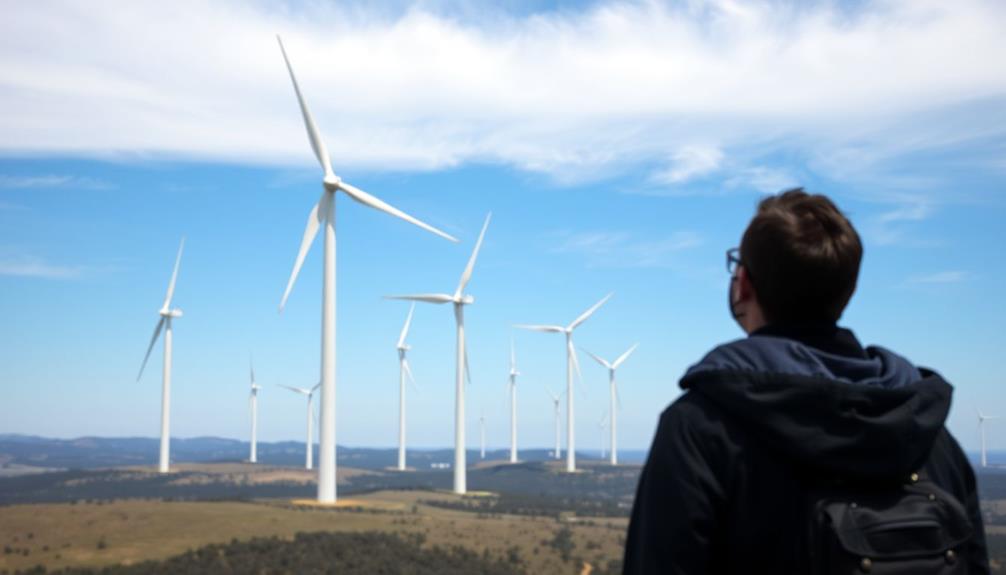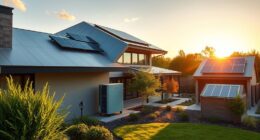Modern wind turbines stand impressive tall, with an average hub height of about 103.4 meters (339 feet) as of 2023. These towering structures maximize energy production by capturing stronger winds higher off the ground. Rotor diameters have also expanded, averaging over 133.8 meters (438 feet), enhancing their efficiency. While onshore turbines have regulation limits, offshore designs are projected to reach heights of 150 meters (500 feet) by 2035. As advancements continue, the future may see turbines exceeding 300 meters. Discover how these heights impact renewable energy innovation and play a role in sustainability.
Key Takeaways
- As of 2023, the average height of utility-scale land-based wind turbines is approximately 103.4 meters (339 feet).
- Hub heights for offshore turbines are projected to reach up to 150 meters (500 feet) by 2035.
- Tower heights have increased by 83% since 1998-1999, enhancing energy production efficiency.
- Taller turbines can access stronger winds, boosting energy generation by 10-20%.
- Future designs may push turbine heights beyond 300 meters for improved energy capture capabilities.
Overview of Wind Turbines

When you think about renewable energy, wind turbines often come to mind as a powerful solution for harnessing nature's energy. These towering structures convert the kinetic energy of wind into electrical energy, playing an essential role in today's energy landscape.
The height of modern wind turbines has greatly increased, with utility-scale land-based models reaching an impressive 103.4 meters (~339 feet) by 2023. This height allows turbines to capture stronger winds, which translates into more power generation. Additionally, optimizing content through high-quality research can further enhance the credibility of information surrounding renewable energy technologies.
The rotor diameter of newly installed turbines has also expanded, exceeding 133.8 meters (~438 feet) in 2023. Larger blades enable turbines to sweep a greater area, enhancing their capacity to produce electricity. Ranging from 60 to 120 meters in height, some advanced designs even stretch up to 200 meters, optimizing energy production efficiency.
This increase in size and height has led to remarkable advancements in capacity. For instance, the average capacity of newly installed U.S. turbines in 2023 reached 3.4 megawatts (MW), marking a staggering 375% increase since 1998-1999.
With each advancement, wind turbines continue to solidify their role in the renewable energy revolution.
Importance of Tower Height

When it comes to wind turbines, tower height plays an essential role in energy production efficiency.
Taller towers can access stronger winds, boosting the amount of energy generated by 10-20%.
Additionally, oversized turbines contribute to significant energy production, especially when coupled with ideal wind speeds electricity output from turbines.
Plus, considering environmental impacts, refining tower height can lead to more effective energy solutions.
Energy Production Efficiency
The height of wind turbine towers plays an essential role in energy production efficiency, as taller turbines can tap into stronger winds found at higher altitudes. This increased access to wind energy available considerably boosts power output.
With the average hub height of utility-scale turbines rising to around 103.4 meters (339 feet) in 2023, we're witnessing a remarkable evolution in wind energy technology. Additionally, the trend towards sustainability has encouraged innovations in turbine design, similar to the diverse tent camping locations found in New England.
Here are four key benefits of taller turbines:
- Increased Efficiency: For every 10% increase in height, energy production can increase by 10%.
- Enhanced Capacity: Taller turbines can boost energy capacity by up to 10% compared to shorter models.
- Larger Turbines: The trend toward larger turbines, with an average capacity of 3.4 megawatts (MW), reflects a focus on efficiency.
- Stronger Winds: Access to ideal wind conditions at elevated heights means more consistent energy generation.
Wind Speed Benefits
Taller wind turbine towers greatly enhance wind speed benefits, allowing turbines to capture stronger winds at greater heights. By increasing the hub height, you access higher elevations where wind speed typically rises, leading to improved energy production.
In 2023, the average hub height for utility-scale land-based turbines reached approximately 103.4 meters (339 feet). This height enables turbines to harness more wind energy, increasing efficiency by 10-20%. Additionally, the trend towards taller towers aligns with strategies for diversification of retirement portfolio, as both fields focus on maximizing returns through optimized resources.
As you consider offshore turbines, the trend continues, with projections showing hub heights increasing from 100 meters (330 feet) in 2016 to 150 meters (500 feet) by 2035.
These advancements in design focus on optimizing height, maximizing energy capture from available wind resources. Taller towers not only allow for better wind speed but also accommodate longer blades, further enhancing energy production capabilities.
Environmental Considerations
Considering the significance of tower height in wind energy, it's clear that taller turbines play a crucial role in minimizing environmental impact while maximizing energy output. By reaching heights of over 100 meters, these turbines access stronger winds, improving production efficiency by 10-20%.
Additionally, the increasing focus on cybersecurity measures in technology can enhance the monitoring and operational safety of wind farms. However, height also brings environmental considerations.
Here are four key factors to keep in mind:
- Minimized Land Use: Taller wind turbines can cover larger areas of land with fewer installations, reducing the overall footprint of wind energy projects.
- Impact on Local Wildlife: Increased height can affect local wildlife, particularly birds, necessitating careful siting to mitigate risks.
- Access to Stronger Winds: Taller turbines can harness higher wind speeds, leading to increased energy output and making wind energy more viable.
- Future Projections: Offshore turbines are set to rise to 150 meters by 2035, further enhancing their ability to capture powerful winds while considering ecological impacts.
Ultimately, careful planning is essential to balance the benefits of taller wind installations with their environmental impact, ensuring sustainable wind energy development.
Hub Height Trends

Historically, wind turbine hub heights have steadily increased, reflecting a clear trend in the industry. Since 1998-1999, the hub height of utility-scale land-based wind turbines has surged by 83%, now averaging about 103.4 meters (339 feet) in 2023.
This growth isn't just limited to land-based turbines; offshore wind turbines are expected to follow suit, with projections indicating hub heights could rise from 100 meters (330 feet) in 2016 to an impressive 150 meters (500 feet) by 2035. This trend mirrors advancements in other energy-efficient technologies, such as the best heat pumps, which also focus on optimizing performance and sustainability.
Taller turbines capture more energy due to the increased wind speeds found at higher altitudes, considerably enhancing energy production. You'll find that most turbines over 100 meters are primarily in regions like the Midwest and Northeast, where wind shear conditions are particularly favorable.
The push towards greater hub heights is driven by the ongoing need for improved energy production capabilities in wind energy generation. As you explore these trends, you'll see that investing in taller turbines is essential for maximizing efficiency and harnessing the full potential of wind energy.
The future of wind energy is looking up—literally!
Rotor Diameter Developments

As you explore rotor diameter developments, you'll notice a clear trend towards larger sizes, with average diameters exceeding 133.8 meters in 2023.
These increases in rotor size have a significant impact on energy production, allowing turbines to capture more wind and generate more electricity.
This advancement in technology not only boosts efficiency but also reflects the industry's commitment to harnessing renewable energy effectively.
Additionally, just like mastering the art of bug out bags enhances preparedness, optimizing turbine design is essential for maximizing energy output and sustainability.
Increasing Rotor Sizes
In recent years, the trend toward increasing rotor sizes in wind turbines has transformed the landscape of wind energy generation. The average rotor diameter of new wind turbines in 2023 exceeded 133.8 meters (about 438 feet), marking a significant leap from previous models.
This upward trend reflects a wider shift in design to maximize energy production, similar to the way cold medications must be selected carefully for effective relief.
Here are some key points about larger rotor sizes:
- Wider Swept Areas: Rotor swept areas have increased by roughly 670% since 1998-1999, allowing turbines to capture more wind energy.
- Height Matters: Larger rotor diameters enable turbines to sweep a greater area, enhancing their capability to harness wind energy effectively.
- U.S. Adoption: By 2023, about 98% of newly installed turbines in the U.S. featured rotor diameters of 115 meters (380 feet) or larger.
- Future Growth: Advancements in technology are driving the growth in rotor size, ensuring even greater efficiency in wind energy generation.
This trend toward larger rotors not only improves energy production but also positions wind turbines as a vital component of sustainable energy solutions.
Impact on Energy Production
With advancements in rotor diameter developments, wind energy production has reached new heights. In 2023, the average rotor diameter of new wind turbines exceeded 133.8 meters (approximately 438 feet), a significant leap from earlier designs. This increase in height and blade size has allowed turbines to sweep a larger area, directly boosting their capacity to increase electricity production.
As highlighted by the principles of design thinking, this innovative approach can help in understanding user needs and optimizing energy solutions. Since 1998-1999, rotor swept areas have surged by around 670%, enabling each turbine to generate more energy. In fact, 98% of new wind turbine installations in the U.S. now feature rotors 115 meters (380 feet) or larger, highlighting the industry's shift toward larger diameters for enhanced energy capture.
These larger rotor diameters translate into higher efficiency, with newly installed turbines boasting an average capacity of 3.4 megawatts (MW) in 2023. The correlation between rotor size and wind power capabilities is clear: the bigger the rotor, the better the energy capture.
As wind turbines continue to evolve, you can expect even greater advances in energy production, making wind a central player in the shift to renewable energy.
Offshore Vs. Onshore Heights

While both offshore and onshore wind turbines play essential roles in renewable energy generation, their heights differ markedly due to environmental and regulatory factors. Offshore turbines are typically designed to maximize energy capture from stronger wind speeds at sea, leading to a projected hub height increase from 100 meters (330 feet) in 2016 to 150 meters (500 feet) by 2035.
As the demand for renewable energy grows, investments in technology and infrastructure, similar to those found in the precious metal investment options, are expected to enhance turbine efficiency. In contrast, onshore turbines have an average hub height of about 103.4 meters (339 feet) as of 2023, having increased by 83% since 1998-1999.
Here are four key differences between offshore and onshore heights:
- Height Advantage: Offshore turbines are generally taller, with some future designs exceeding 300 meters.
- Regulatory Constraints: Onshore turbines must adhere to aviation regulations, particularly when exceeding 152 meters, requiring FAA notification.
- Environmental Resistance: Offshore turbines are engineered to withstand harsh marine conditions, impacting their design and height.
- Wind Speed Utilization: The increased height of offshore turbines allows them to harness higher wind speeds, enhancing efficiency and capacity.
Understanding these differences is essential for appreciating the wind energy landscape.
Future of Wind Turbine Design

The future of wind turbine design promises notable advancements that will reshape the renewable energy landscape. You can expect taller structures, with offshore turbines projected to reach hub heights of 150 meters (500 feet) by 2035. This increase in height will greatly enhance energy capture capabilities, allowing for more efficient wind energy generation.
As technology evolves, designs could push turbine heights beyond 300 meters, opening up even greater potential for harnessing wind power. The trend toward larger rotor diameters continues, with a remarkable 98% of new installations in 2023 featuring rotors measuring 115 meters (380 feet) or larger. This growth in rotor size plays a vital role in improving efficiency and maximizing power output.
Moreover, researchers are focusing on optimizing entire wind plants instead of just individual turbines, which could further elevate efficiency levels across the board.
Floating wind turbine technology is also gaining traction, enabling installations in deeper waters and expanding the possibilities for wind energy generation in previously inaccessible areas. Embracing these innovations won't only increase energy output but also contribute to a cleaner, more sustainable future.
Frequently Asked Questions
What Is the Height of Modern Windmills?
You're looking at modern windmills typically ranging from 60 to 200 meters tall. These heights enable them to capture stronger winds, greatly boosting energy production efficiency by 10-20% compared to shorter models.
What Is the Tallest Wind Turbine in the Us?
The tallest wind turbine in the U.S. is the GE Haliade-X, standing at 853 feet. Its impressive rotor diameter of 220 meters helps capture stronger winds, greatly boosting energy production compared to shorter models.
Why Are Modern Windmills so Tall?
Modern windmills are tall because their height allows you to capture stronger winds, improving energy efficiency. Taller turbines can sweep larger areas, generating more electricity, making them essential for sustainable energy production.
How High Are the Highest Wind Turbines?
You might be surprised to learn just how high wind turbines can reach. Some proposed designs aim for staggering heights of up to 650 feet, while the tallest currently exceed 500 feet, pushing energy production limits.
Conclusion
As you explore the world of wind turbines, picture these towering giants dancing gracefully with the wind, their blades slicing through the air like a falcon in flight. The heights of these modern marvels not only harness nature's energy but also symbolize progress and innovation. With each rise in hub height and rotor diameter, we're reaching for the skies, paving the way for a cleaner, greener future. The journey of wind turbine design is just beginning, and it's exhilarating!










